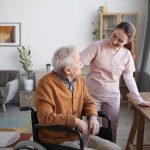How to Adapt a Home for Seniors or Individuals with Mobility Challenges
For seniors or individuals with limited mobility, everyday tasks such as climbing stairs or getting into the bathtub can become significant challenges. The good news is adapting a home to be safe and comfortable is not only feasible but often easier and more affordable than many people imagine. Here we share practical recommendations to transform the home into a safer, more comfortable, and functional space.
1. Clear Entryways and Entrances
Entry areas and doorways should facilitate safe entrance and exit. Steps to take:
– Remove rugs and any objects that could cause tripping.
– Consider installing a gentle ramp instead of stairs, especially if wheelchairs or walkers are used.
– Install sturdy handrails to assist older adults when entering and exiting.
– Ensure good lighting at entryways and doorways to improve visibility and minimize risks.
2. Non-slip Flooring
Choosing floors that offer safe and slip-resistant surfaces is essential:
– Place non-slip mats in areas such as bathrooms and kitchens.
– Consider installing textured wood or resilient vinyl flooring to prevent falls.
3. Bedroom and Furniture Adjustments
Adapting bedrooms for ease of movement and accident prevention is crucial:
– Beds should be at an appropriate height—neither too high nor too low. Adjustable-height beds are excellent alternatives.
– Install support bars or bed rails near the bed to help with lying down and getting up.
– Avoid furniture with sharp edges or arrange furniture to create clear, open space for walking.
– Incorporate a stable seat for dressing or putting on shoes.
4. Accessible and Safe Bathrooms
Bathrooms carry the highest risks of home accidents. Recommended modifications include:
– Installation of grab bars in showers, tubs, and around toilets.
– Replacing traditional bathtubs with walk-in or curbless showers for easy access.
– Including a secure, comfortable shower seat.
– Fitting single-lever faucets to prevent excessive strain.
5. Functional and Accessible Kitchen
Kitchens should simplify daily tasks:
– Place everyday items (plates, glasses, utensils) in easily reachable cabinets or shelves.
– Use organizers or pull-out shelves that prevent excessive stretching or bending.
– Set appliances frequently used at waist height for easy access.
6. Proper Lighting and Visibility
Proper lighting is a priority in senior-friendly homes:
– Add night-lights in hallways, bedrooms, and bathrooms to assist with orientation at night.
– Use adjustable LED lights to modify the brightness according to visual needs.
– Position light switches at lower heights or install easy-to-use smart switches.
7. Assistive Technology and Devices
Technology can significantly contribute to overall safety:
– Install medical alert systems or emergency push-button pendants.
– Consider sensors or smart devices that detect falls or prolonged inactivity.
– Integrate virtual assistants or simple voice-activated smart-speaker devices to ease communication and quickly request assistance.
8. Comfortable Leisure and Activity Zones
Designing spaces specifically for rest or recreational activity encourages a healthier home environment:
– Ensure sofas, chairs, and seating options are stable, have comfortable armrests, and assist standing comfortably.
– Use special padding to cover sharp edges or corners of furniture.
– Designate a safe, accessible area for exercises or other activities that encourage mobility.
Home Adaptation Means Better Quality of Life
Each adaptation significantly enhances the physical, emotional, and mental well-being of seniors or individuals with limited mobility. Making their environment accessible helps maintain their independence and autonomy longer and provides peace of mind for family members and caregivers alike.
If you require personalized advice on these adaptations or seek specialized home care assistance, at Home Care Concepts we have skilled staff ready to support you in enhancing quality of life in your home.
Reach out today—we’ll be delighted to assist you every step of the way.


